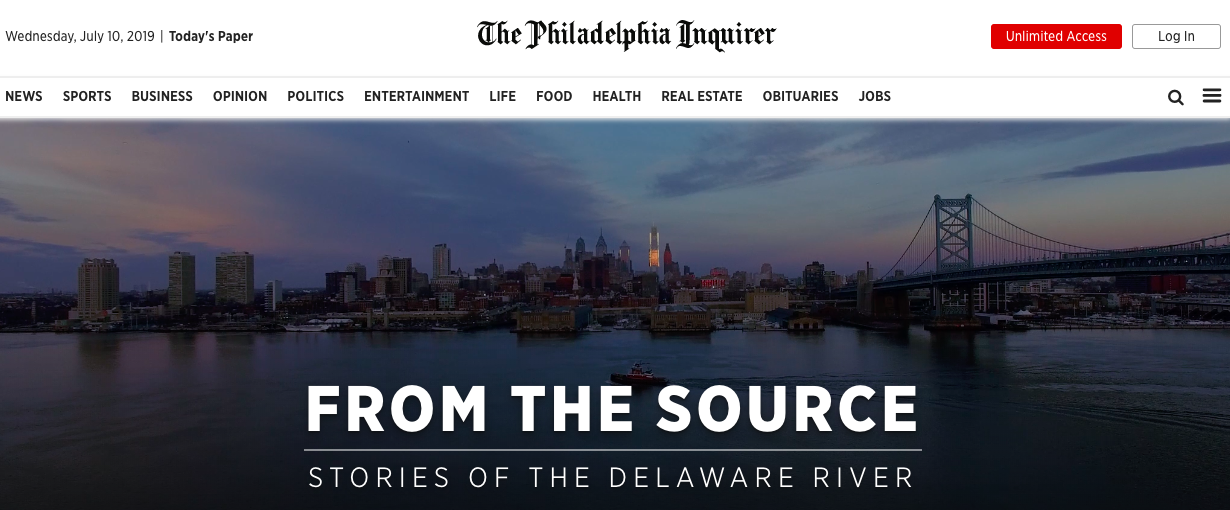Journalists in local newsrooms are teaming up to cover climate change. If that lead seems familiar, it’s because it’s happening a lot these days.
But the latest example includes something new – the resources of the National Geographic Society.
The two collaborative reporting projects around the Delaware River Watershed and the Ohio Watershed, announced Wednesday, are part of a $650,000 project from The Lenfest Institute, The National Geographic Society and the William Penn Foundation.
“The goal is to look at a global issue through a devout local lens: Climate change brought home,” said Jim Friedlich, executive director and CEO of the Lenfest Institute, via email.
(Disclosure: Lenfest funds projects at Poynter.)
The goal, he said, is to build the capacity for long-term environmental reporting and to serve as a test case.
“Each participating news organization will learn from – and help teach – the project in their own right, but also build connective tissue between news organizations serving the same watershed, for the long haul.”
The National Geographic Society will add its network of visual journalists, technologists and scientific experts, said Joseph Lichterman, Lenfest’s manager of editorial and digital strategy, in an email.
“Effectively, they’re going to help connect the people who do all the amazing National Geographic journalism to the local newsrooms,” he said.
So far, that includes working with the Philadelphia Inquirer on mapping to develop interactive watershed maps and an upcoming photo camp workshop. The Inquirer’s first installment in the project published Wednesday.
Newsrooms involved in “From the Source: Stories of the Delaware River,” which officially launches this fall, include The Inquirer, public TV station WLVT, Delaware Public Media and Delaware Currents. Newsrooms taking part in the Ohio Watershed Reporting Collaborative include PublicSource, Allegheny Front, 100 Days in Appalachia, Louisville Public Media, The Ohio Center for Investigative Journalism, Belt Magazine and Environmental Health News.
The two partnerships are among many recently that bring together local newsrooms to cover the environment. Take, for example:
- The Pulitzer Center’s Connected Coastlines, which is open for funding applications and “aims to increase awareness in local communities that are already navigating changing weather, flooding, and temperature patterns due to climate change.”
- Five Florida newspapers and one public radio station announced recently that they’ll team up to cover climate change, building off a previous project that brought many of those newsrooms together to cover sea-level rise. “Florida is ground zero for the effects of sea rise,” Tampa Bay Times executive editor Mark Katches wrote. “It may be the most important subject of our time. Our new partnership represents just one creative way we can keep readers better informed on topics that matter.” (Disclosure: Poynter owns the Times, and I work with them once a week on a separate project.)
- A Midwest collaboration led by InsideClimate News brought 14 local newsrooms together to take on stories about transportation, agriculture and the electric grid. “We’re trying to engage and create more energy and climate change journalism locally,” InsideClimate’s executive editor Stacy Feldman told Poynter last month.
- Starting last year, The Texas Observer worked with Quartz on climate change in Texas with Shallow Waters. “I didn’t want to just parachute our people in without having any local experience,” Quartz health editor Elijah Wolfson told the Center For Cooperative Media.
- And The New York Times worked with New Orleans’ Times-Picayune last year on coastal erosion. “The local news organizations have expertise,” NYT’s executive editor Dean Baquet told Poynter then, “and we have resources.”
Expect to see more collaborations on the environment, said Stefanie Murray, director of the Center for Cooperative Media.
“Complex topics, investigations and issues that impact a lot of people lend themselves well to journalistic collaboration,” she said in an email. “The climate crisis hits all of these areas, which is one part of the reason why we’re seeing so many collaborations focusing on the environment.”
If you’re not part of an environmental collaboration, she said, join one or start one. (Murray shared that Media Impact Funders will host a free webinar on ways to fund environmental reporting.)
It’s among the major stories of our time, Friedlich said, “and we are deeply committed to supporting its coverage. How tragic would it be were the waters of the Delaware to flow through an environmental news desert on their way to the sea?”







